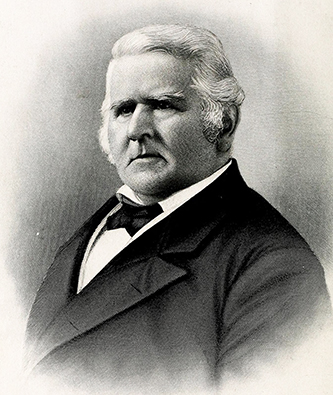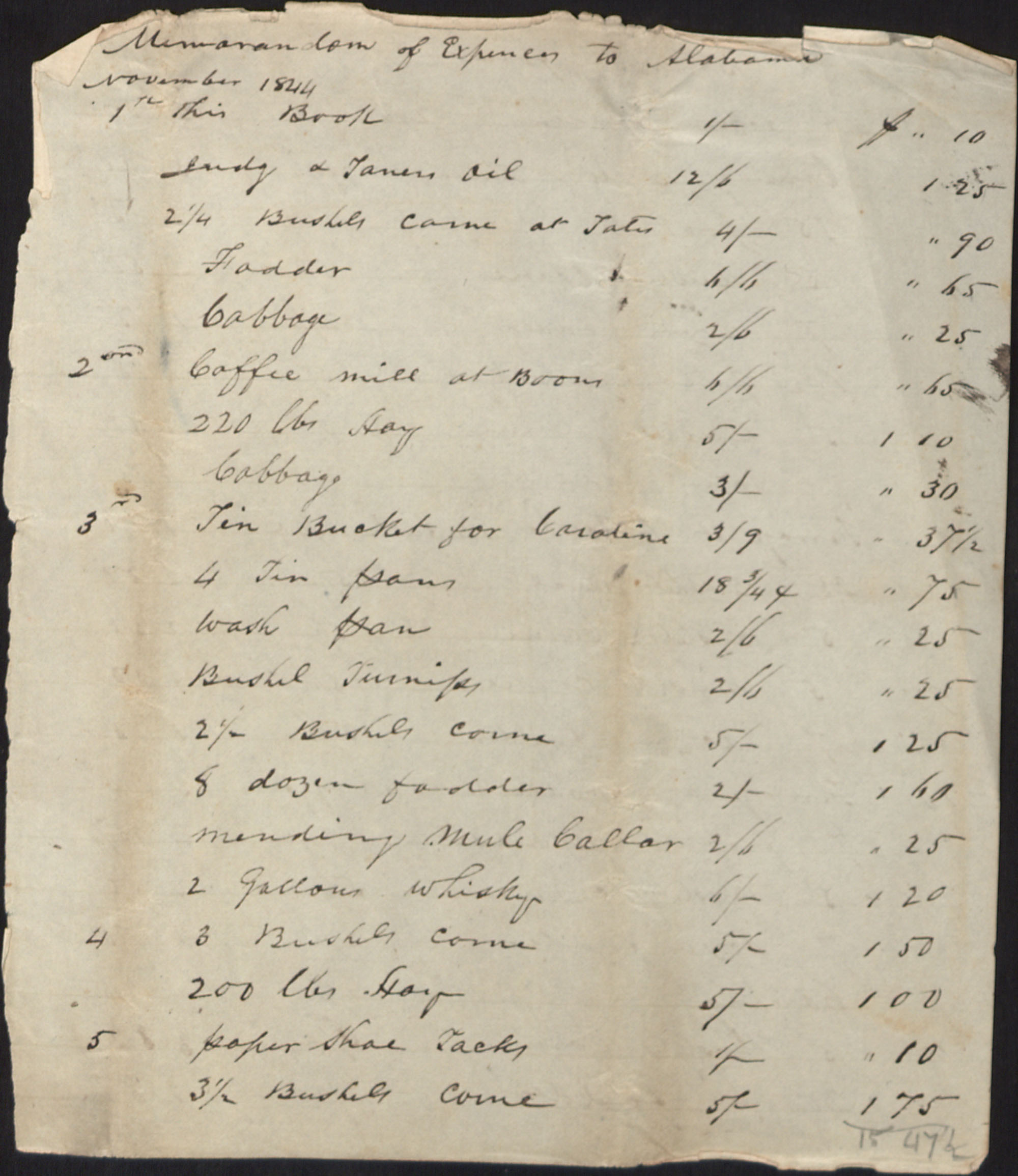The Cameron family of Orange County was one of antebellum North Carolina's wealthiest families and among its most prolific enslavers.
Paul C. Cameron was the son of Duncan Cameron. He was born in 1808 at Stagville plantation near Durham, North Carolina. Although he studied law, Paul was more interested in agricultural reform. In 1843 he inherited his uncle's share of the family's estate, and he inherited most of his father's property in 1855.
Paul used his enormous wealth to expand his family's fortunes, purchasing plantations in Mississippi and Alabama. The document on this page is an excerpt of records he kept about the costs of setting up a new plantation in Greene County, Alabama.
In the first (left) column is a description of each item. The second column is some type of measurement, but it is unclear from the document what Cameron was recording. The last column is the total cost.
On the eve of the Civil War, Paul Cameron and his siblings enslaved more than one thousand people and owned nearly thirty thousand acres of plantation land in Orange, Wake, Person, and Granville counties, as well as plantations in Alabama and Mississippi.
Memorandom of Expenses to Alabama
November 1844
|
1st |
This Book |
1/- |
.10 |
|
[illegible] & Tanners Oil |
12/6 |
1.25 |
|
|
2 1/4 BushelsA bushel is a unit of measurement for corn, fruit, or vegetables. A bushel of corn weighs 56 pounds. corn at Tates (?) |
4/1 |
.90 |
|
|
FodderFodder is food for cattle. |
6/6 |
.65 |
|
|
Cabbage |
2/6 |
.25 |
|
|
2nd |
Coffee mill at Boon |
6/6 |
.65 |
|
220 lbs Hay |
5/- |
1. 10 |
|
|
Cabbage |
3/- |
.30 |
|
|
3rd |
Tin Buckets for Caroline |
3/9 |
.37 1/2 |
|
4 tin pans |
18 3/4 & |
.75 |
|
|
wash pans |
2/6 |
.25 |
|
|
Bushel turnips |
2/6 |
.25 |
|
|
2 1/2 Bushels Corne |
5/- |
1.25 |
|
|
8 dozen fodder |
2/1 |
1.60 |
|
|
mending mule collor |
2/6 |
.25 |
|
|
2 gallons whiskey |
6/- |
1.20 |
|
|
4 |
3 Bushels Corne |
5/1 |
1.50 |
|
200 lbs hay |
5/- |
1.00 |
|
|
5 |
poper shoe tacks |
1/- |
10 |
|
3 1/2 bushels corne |
5/- |
1. 75 |
|
|
15. 47 |
|||
|
8 dozen fodder |
2/6 |
2.00 |
|
|
Crosing bridge at Atkin 4 waggons |
3.00 |
||
|
75 footWhen Cameron crosses a river, there are usually two entries: one for the wagons and one for a single horse. This is probably what he paid for a single horse to cross at this river. The wagons were driven by slaves and Cameron was on his own horse. It was a symbol of status to ride your own horse. |
3.75 |
||
|
6 |
5 bushels corne |
5/- |
2.50 |
|
7 dozen fodder |
2/6 |
1.75 |
|
|
1 1/2 gallons whisky |
5/- |
75 |
|
|
7 |
5 Bushels corne |
5/- |
2.50 |
|
7 dozen fodder |
2/6 |
1.75 |
|
|
8 |
Ferry at Catawba 64 foot |
6/4& c |
4.00 |
|
25 bushels mazeMaize, or corn. |
5/- |
12.50 |
|
|
9 |
5 bushels corne |
5/- |
2.50 |
|
7 dozen fodder |
2/6 |
1.75 |
|
|
10 |
Ferry at Broad RiverThe Broad River runs southwesterly through Rutherford, Polk, and Cleveland counties in North Carolina and into South Carolina. 4 waggons |
3.00 |
|
|
70 foot single horse |
4.43 3/4 |
||
|
5 bushels corne |
5/- |
2.50 |
|
|
7 dozen fodder |
2/6 |
1/75 |
|
|
cabbage |
2/6 |
.25 |
|
|
11 |
5 bushels corne |
6/3 |
12 1/2 |
|
200 lb fodder |
7/6 |
2.50 |
|
|
73.28 3/4 |
|||
|
12th |
5 bushels corne |
5/- |
2.50 |
|
200 lb fodder |
7/6 |
1.50 |
|
|
13 |
3 barrels corn |
||
|
25 dozen fodder |
1/3 |
3.12 1/2 |
|
|
14 |
25 bushels mealCornmeal, probably as food for slaves. |
2/6 |
8.75 |
|
15 |
whisky to drench muleTo drench a mule or other livestock is to force medicine down its throat, but Cameron may have used the phrase simply an expression -- "enough whiskey to drench a mule," as we might say "enough food to feed an army." |
1/3 |
12 1/2 |
|
16 |
5 bushels corne |
5/- |
2.50 |
|
7 dozen fodder |
2/- |
1.40 |
|
|
ferry at Sennica River The Seneca River is formed by the confluence (joining) of the Keowee River and the Little River in northern South Carolina, then joins the Tugaloo to form the Savannah River. |
4.72 1/2 |
||
|
17 |
Ferry at Tugalow RiverThe Tugaloo River runs along the border between South Carolina and Georgia. |
4.72 1/2 |
|
|
8 dozen fodder |
2/- |
1.60 |
|
|
18 |
5 bushels corn |
4/- |
2.00 |
|
85 bunches fodder |
1¢ |
.85 |
|
|
5 bushels corne |
4/- |
2.00 |
|
|
5 quarts brandy |
2/6 |
1.25 |
|
|
19 |
5 bushels corn |
4/- |
2.00 |
|
95 bunches fodder |
1 ¢ |
.85 |
|
|
20 |
5 bushels corne |
3/6 |
1. 75 |
|
170 lbs. fodder |
5/- |
.85 |
|
|
2 bushels cleaned oats |
2/6 |
.50 |
|
|
127.78 3/8 |
List of Property on the Plantation Greene Co Alabama Dec 1846
- 110 Slaves. Men 31 Boys. 12. Women. 28 - Girls 10 - children 29
- 4 Horses
- 25 Mules
- 160 hogs
- 10 2 horse ploughs
- 22 1 horse ploughs
- 10 1 horse Bull [illegible]
- 3 Wagons and gear
- 7 Doz weeding hoes
- 8 Sythe BladesA scythe is a tool used for cutting grass or grain. It has a long neck, a handle half way down, and a curved blade. A person would swing the scythe up into the air and then sweep it through the grass or grain in a long stroke. & cradlesA grain cradle is a light wooden frame with a row of long curved teeth parallel to the blade that can be attached to a scythe. It is used to catch corn or other grain that has been cut by the scythe.
- 9 cutting knives
- 16 axes out. 6 in
- 10 MattocksA mattock is similar to a pick but has a blade on one end and a chisel on the other. It is used for cutting up hard ground. and cane hoes
- 24 pair trace chains
- 21 halterA halter is a rope or a series of straps which is placed over the head and neck of a cow or horse. Halter chains attach to the halter. The chain is then fastened to a machine or cart that the animal pulls. chains
- 21 head cattle
- 1 piece of bagging 5 coil rope
- 57 hats 5 caps 25 pair shoes q old stock on hand-over
P. L. Cameron, Memorandum of Cash Received and Disbursements on account of Plantation in Greene Co. Alabama for 1846
|
November 1846 Cash advanced by D. Cameron |
$1000.00 |
|
December 1845 Cash advanced by Jastt. Stewart & Co |
325. 00 |
|
My draft to Char. Lewelly on Jastt Stewart & Co |
100. 00 |
|
My order to Jastt. Stewart & Co, in favor Jas H. Ruffin |
50.00 |
|
Cash advanced by P. C. Cameron |
125.20 |
|
$1600.20 |
*The order for $50 in favor of Jas H. Ruffin is cash loaned in June to Lewelly an is accounted for as cash to me, and makes a part of the disbursements
Money paid by Paul C. Cameron in Connection with the plantation in Greene Co. Ala winter of 1845 & 6
|
Expenses out to Columbia $ 10. Augusta $16. 75 Atlanta $7 Cheraw [?]13 Montgomery $2.50, Selma $3. Greensboro $8 |
|
|
Plantation $1 Meals, lodging and PorterageA charge for carriage or transportation. $12 - |
$69.00 |
|
Cash Paid collector of Green Co. Taxes on Land & Slaves 1845 |
87.47 |
|
Cash Paid Garner & Whitel Negro Clothing |
47. 83 |
|
Cash Paid Barrow and Mead 2 bills Groceries |
57. 75 |
|
Cash Paid O Mazange 2 bills Hard ware / see bills |
37. 66 |
|
Cash Paid Carter & Robinson Medicines |
3. 55 |
|
Cash Zigs and Barney. Hard ware |
52.43 |
|
Cash Paid W. C. Oliver freight and S. B. Victoria |
5.50 |
|
Cash Paid Toal bridge 5$ cabbage sud $ 1 Candles & blacking |
$2 |
|
Cash Paid for a Coru Negroes for good work $1 Part of / 2 |
9.05 |
|
Cash paid 5ty Shoe Thread - $2.50 S B Warrion freight |
$6.87 |
|
Cash Paid Charly Lunellzen oversees for 1845 |
600.00 |
|
Cash Paid Dr. Wm Pricy his bill |
126.75 |
|
Expenses at Mobile $20 Expenses horse - $60 |
80.00 |
|
$1142.40 |
Primary Source Citation:
Cameron Family Papers, Collection # 133, Series 2.1.1 Box 88 Folder 2012. Southern Historical Collection, University of North Carolina at Chapel Hill.

